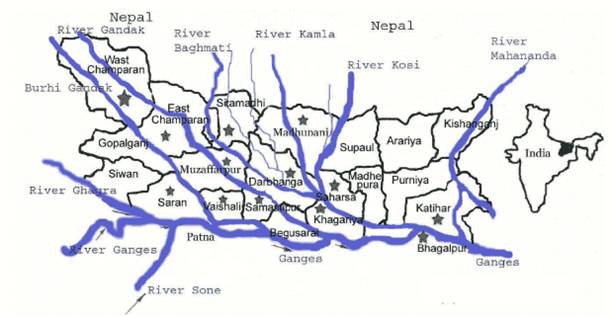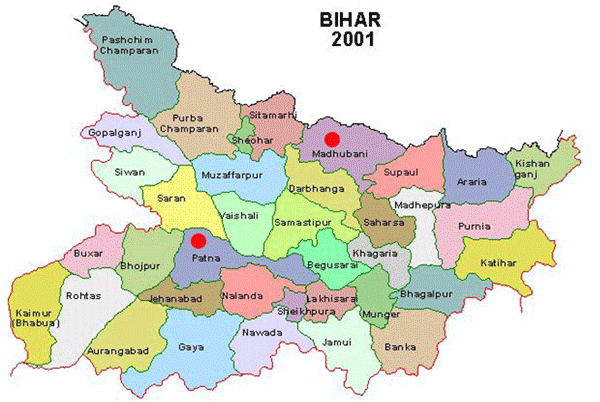Urgent Appeal for Bihar Floods-2014
Dear friends and Supporters
In the previous 29 years Voluntary Organisation (VO) Samajik Shaikshanik Vikas Kendra (SSVK) Bihar has worked extensively on Relief and Rehabilitation in a series of disaster like Earth Quake, Fire , Cyclone and Floods including Research and developmental programmes in India. This is an urgent appeal to provide support . The situation is alarming due to continuous heavy rain in the state and the catchment areas in Nepal and millions of people,s are affected by the flood devastation.
Bihar Flood Background

Bihar is India’s most flood-prone State, with 76% of the population in the north Bihar living under the recurring threat of flood devastation. 16.5% of the total flood affected area in India is located in Bihar while 22.1% of the flood affected population in India lives in Bihar. About 68,800 square kilometers out of a total geographical area of 94,160 square kilometers comprising 73.06% is flood affected. The plains of Bihar, adjoining Nepal, are drained by a number of rivers that have their catchments in the steep and geologically nascent Himalayas. Kosi, Gandak, Burhi Gandak, Bagmati, Kamla Balan, Mahananda and Adhwara Group of rivers originates in Nepal, carry high discharge and very high sediment load and drops it down in the plains of Bihar. About 65% of catchments area of these rivers falls in Nepal/Tibet and only 35% of catchments area lies in Bihar. A review by Kale (1997) indicated that the plains of north Bihar have recorded the highest number of floods during the last 30years. In the years 1978, 1987, 1998, 2004 and 2007 Bihar witnessed high magnitudes of flood. The total area affected by floods has also increased during these years. Flood of 2004 demonstrates the severity of flood problem when a vast area of 23490 Sq Km was badly affected by the floods of Bagmati, Kamla & Adhwara groups of rivers causing loss of about 800 human lives, even when Ganga, the master drain was flowing low. Floods in Bihar are an annually recurring disaster affecting huge human and livestock population and causing huge damages to agricultural crops, houses and public infrastructure. In between 1979 and 2006, floods of varying intensity have ravaged Bihar on an annually recurrent basis affecting on an average an area of 1.39 mha, a human population of 7.71million and a livestock population of 1.55 million per annum. Crop losses have been on an average to the tune of Rs 1423.33 million per annum and that of public property to the tune of Rs 568.30 million. Loss of human lives has been on an average of 210 per annum and that of livestock at 680 per annum.

District Map of Bihar
Flood August 2014
Flood August 2014
According to bihar Officials The flood situation in Bihar worsened Saturday with a river breaching its embankment in Darbhanga ,West Champaran and other districts and affectingmore than 7 lacs people,s.
Kamala Balan river, swelled by the flood waters of its tributaries, breached the west embankment near Kumrol and Rasiyari Baur villages in Ghanshayampur block of Darbhanga districts (Bihar)
The flood waters then submerged over a dozen villages, affecting thousands of people.
In other parts of the state, after heavy donwpour pushed up the water level of Kosi, Gandak and Bagmati rivers, hundreds of villages have been inundated and thousands were marooned.
Principal secretary of state disaster management department, told IANS that that the flood situation is grim. He sounded a high alert as major rivers in north Bihar, especially the Kosi, Gandak, Kamla Balan and Bagmati, are in spate following heavy rains in their catchment areas in Nepal and are posing a threat of floods.
In view of the situation in some areas, eight teams of the National Disaster Response Force (NDRF) and state disaster response force (SDRF) have been deployed in flood-hit districts and
asked by the state govt. for five additional NDRF teams from the central government.
Hundreds fled their homes after water entered their 689 villages of 302 panchayats of 57 blocks in 14 districts Nalanda , Saharsa, Supaul, West Champaran, Madhubani, Darbhanga, Muzaffarpur, Sitamarhi, Patna, Nalanda, Sheohar, Araria, Sheikhpura and Gopalganj out of 38 districts of Bihar (India) This is as per state Govt. report,that is not reliable. Damage is more than this figure.
There are Eight River Basins in Flood Management Information System (FMIS) Focus Areas
1. Gandak
2. Burhi gandak
3. Bagmati
4. Adhwara group
5. Kamla Balan
6. Kosi
7. Mahananda
8. Ganga Stem in Bihar
Government Reponse
The greatest problem confronting the government at this point of time is to evacuate the marooned to safer places. Though the government has deployed National Disaster Response Force (NDRF) and State Disaster Response Force (SDRF).
Food Grains: 326 quintal of flat rice have been distributed among the flood victims of 689 villages of 302 panchayats in the 57 blocks of the 14 districts.
Boats: Motor boats-38, Govt. boats-353 and private boats-529 has been deployed for evacuation.
Problems:
Displaced and shorn of all assets, these people require the support of all concerned to get their life back on the rails.
The SSVK Intervention
Given the numbers affected, post evacuation their immediate survival needs would have to be addressed. The relief camps set up by the government are grossly inadequate to the numbers affected. Most urgently, the Food, Clothing, Temporary Shelter(Tarpaulins & Bamboo) , Drinking Water and Health of these halpless victims need to be addressed It is against this background that SSVK proposes to intervene with extension of relief assistance to 10,000 families with a combined population of 50,000 in the Districts of Darbhanga (Kamla River),West champaran (Gandak River) Supaul and Saharsa (Kosi River). The relief operations would cover 1,000 families each camp would entail extension of food, shelter, safe drinking water and medical support to the affected families. As the victims have been dislocated from their place of habitation with no chances of getting back in the coming says, the relief operations would be organized through 10 relief camps with each camp having a family coverage of 1000 respectively. These relief camps would be set up on at the elevated spots in the flood affected areas where these people have taken shelter.
Recognising the significance of Right to Information in expanding democratic space and in empowering the ordinary citizen to exercise far greater control over the corrupt and arbitrary exercise of state power, SSVK’s engagement with the issue dates back to 1998 long before the Right to Information Act came into being in 2005. The initial efforts of the organisation were geared towards campaigning for the enactment of the Act. As SSVK belives in transparency and we will be updating the status like Audited Accounts/ Photogarphs and Reports on www.ssvk.org You can visit our efforts in Kosi Catastrophy in 2008 on http://ssvk.org/koshi.htm and Cyclone & Fire 2010 http://ssvk.org/kosi_fire.htm
Thus disaster risk management has been one of the defining paradigms for all the developmental initiatives of SSVK in its operational area. Long term Key interventions comprise the following:
- Emergency relief operations involving provision of food, safe drinking water and temporary shelters, extension of medical assistance and provision of boats for facilitating movement of the marooned
- Rehabilitative efforts involving reconstruction of damaged settlements and restoration of livelihoods
- Diversification of livelihood support base
- Strengthening community level coping mechanisms through organisation building and institutional development and promotion of grain banks and contingency fund reserves (gram kosh) amidst affected communities
- Building community capacities to act as first responders in the event of floods
- Networking with all relevant stakeholders around a shared perspective, towards addressing the issue of Bihar floods at all the levels of mitigation, preparedness, response and recovery.
- Advocacy centred initiatives geared towards addressing the root causes of the flooding problem, galvanizing state response and inclusion of the most marginalized in the relief and recovery operations initiated by the various stakeholders – most importantly the government.
Monitoring
Having run numerous relief programmes in the past SSVK has clearly defined procedures for running relief operations.
At the organisational level there would be a Relief Monitoring Committee comprising organisational staff and some community leaders from the affected villages. They would ensure that relief work is accessible in a fair manner to all those who are to be extended coverage and that standards of fairness and transparency are being met. They would undertake regular field routes to review the work in progress, conduct meetings to resolve any problems coming on the sites, ensure adherence to the targetting process and supervise the upkeep of records.
At each camp a display board would be set up with all the details of the intervention and the name of the donor indicated on it. The relevant government officials would be given a copy of the proposal and the approved budget.
A purchasing committee would make all purchase related decisions. Procurement of goods would follow these guidelines:
- the goods are to be of satisfactory quality
- the goods must be delivered in good order and condition and in accordance with the Project timetable
- the price paid for goods represents value for money
- there is open and effective competition in the purchasing process
- a professional approach is reflected in the purchasing process, including ethical behaviour and fair dealing
All accounts, records and assets registers will contain clear audit trails and adequate Project management records in relation to expenditure. The donor or its representative shall have the right to visit the programme at any time and it will be given access to all relevant records, books and accounts.
Reporting
We will be sending to the donor a consolidated report at the end of the project, highlighting the activities undertaken, the processes adopted, relative accomplishments and shortcomings and deviations if any from the proposed intervention along with the rationale for it. The report would be accompanied by consolidated records of the various interventions to facilitate an overall assessment of the intervention. An intensive photo documentation would also be carried out. A consolidated audited financial report of the relief intervention would be made available to the donor. All reports will be published on SSVK website.
Monatary Contributions:
For Logistics and Essential purchases (All monetary contributions are Tax Exempted under u/s 80G of IT Act. Please click for donation bank accounts numbers for Indian and NRI/Foreigners through FCRA http://ssvk.org/donate.htm
Media :
With Best
Deepak bharti
Secretary
SSVK Patna Bihar (India)
Mobiles : +91-94310 25801 / +91-99731 61483
Phone/Fax: +91-612-2522077
Emails : ssvkindia@ssvk.org , info@ssvk.org
Website: www.ssvk.org